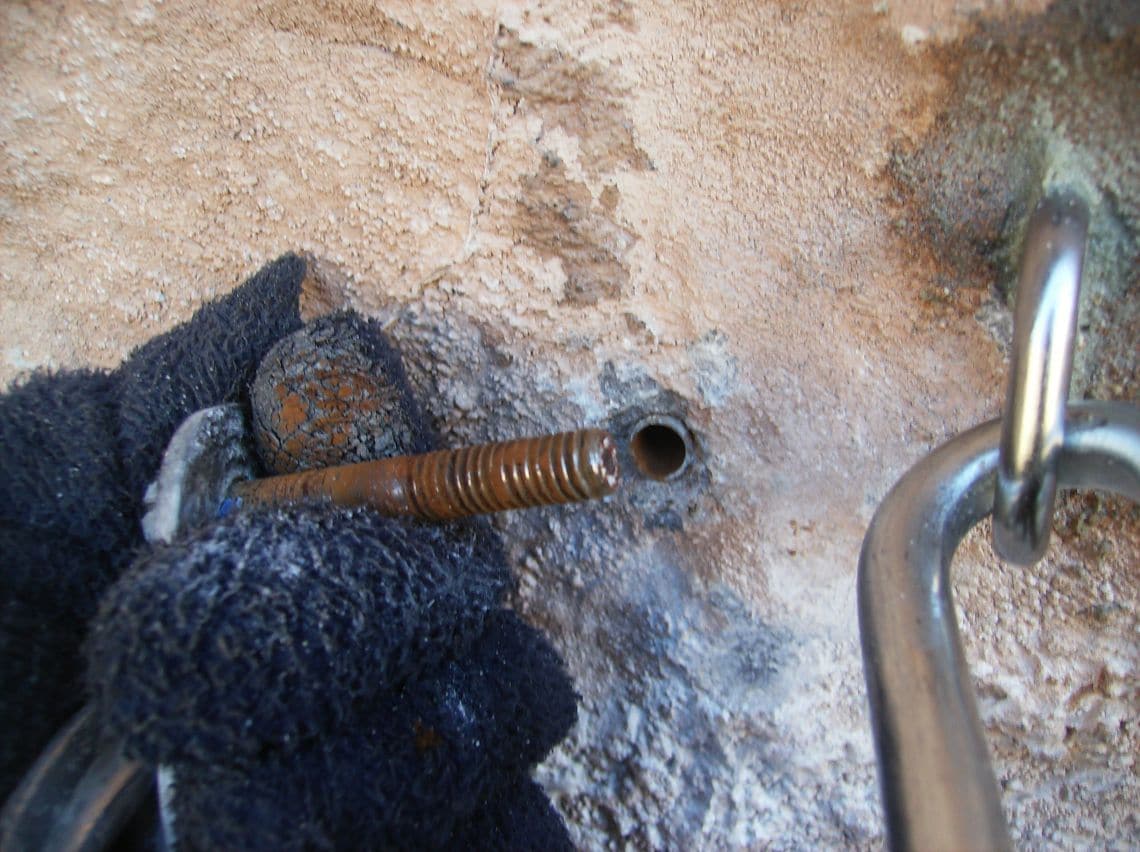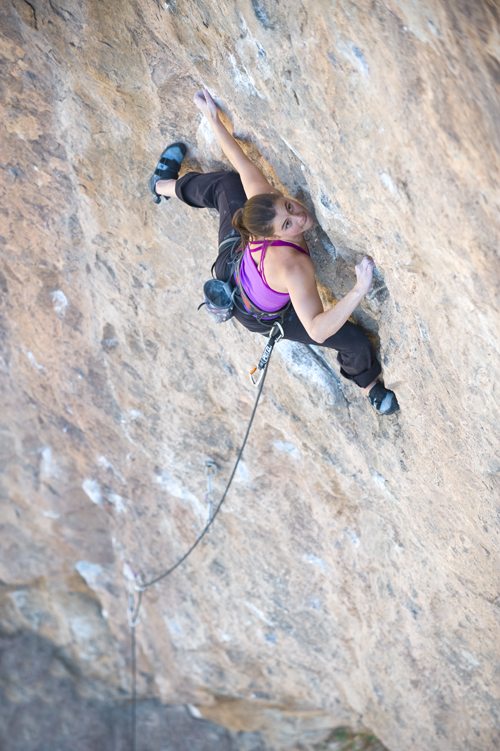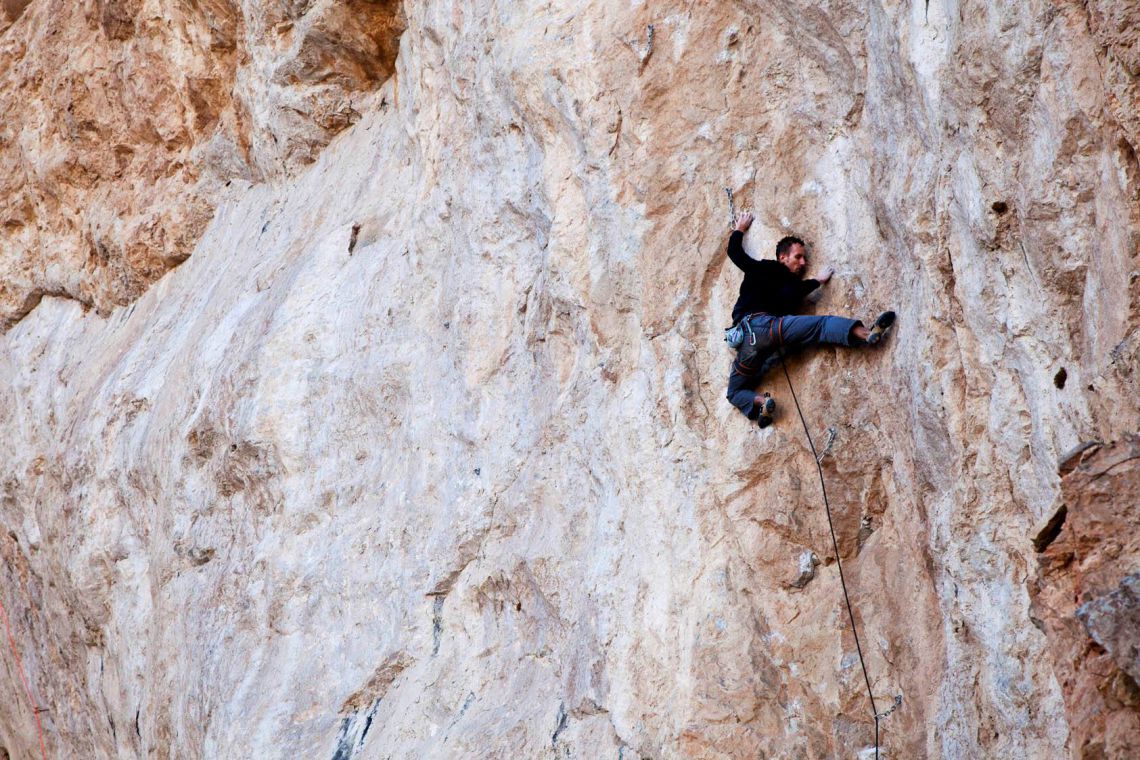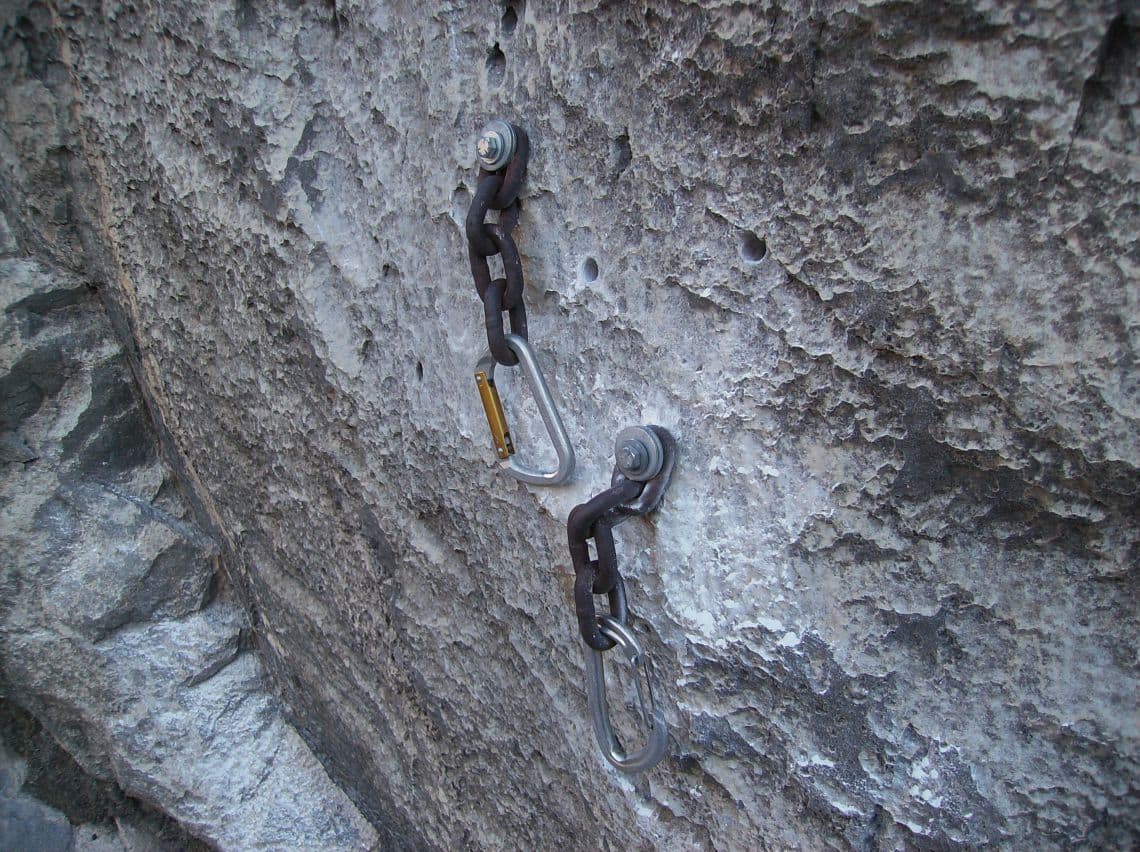Joe Six Pack at the Virgin River Gorge stands as one of the country’s best 5.13a sport climbs. Long, technical and sustained climbing—with a memorable “thumbdercling” crux move at the top of the route—make Joe Six Pack a classic, unforgettable line.
Several years ago, Dan Mirsky was well on his way to onsighting the route when he reached the infamous thumbdercling high on the bulbous, gray slab. At this point, the last quickdraw is a good 15 or 20 feet below your quaking knees. Your belayer can’t see or hear you. And in general, you feel quite exposed to the whipping winds and loud traffic of I-15 hundreds of feet below.
Today, the thumbdercling was wet. Dan pressed his thumb hard into the hold, but popped off, his arms and legs rag dolling through the air. The in-situ nylon sling that was clipped to the last bolt—which had been there for who knows how long—snapped in half and Dan fell for 30, 40, 50 feet. The fall was long enough for Dan to wonder whether his belayer had forgotten to hold the rope. Ultimately he came to a stop having taken a 60-foot whip.
It wasn’t until the snapped sling, still taped to the rope-end carabiner, came pinwheeling down the rope that Dan understood why he had taken such a long fall. And, luckily, the fall was clean and he was unhurt.
The Virgin River Gorge is one of the country’s best, and earliest, sport-climbing areas. Developed in the early 1990s and hailed for having the best limestone in the country, the VRG was the elite haunt for the likes of Randy Leavitt, Boone Speed and Mike Call among many others. To this day, it still draws dedicated weekend warriors piping down the I-15 corridor from Las Vegas all the way to Salt Lake City.
Along with many, if not most, other popular sport climbs in other areas around the country, the most popular routes at the VRG, such as Joe Six Pack, soon came to be equipped with ratty, old, abandoned quickdraws—alumnimum carabiners and nylon slings that were “donated” to the crag either for the convenience of running a quick warm-up or warm-down lap, or were long-term project draws that once belonged to an individual, but were never removed.
In the last few years, sport climbers in America have wrestled with one of the most contentious quagmires in our sport’s history: the issue of whether or not to equip crags with Climb Tech Perma Draws, which are “permanent” quickdraws composed entirely of long-lasting steel, including steel carabiners. Climbers wrestled with the ethic of having permanent quickdraws hanging from their crags, both from an experiential and simply just aesthetic standpoint. Those against Perma Draws correctly pointed to good reasons why perma-draws would be a bad idea, including access issues and the fact that climbers really could easily just put their own draws on a route with each and every attempt, taking them down each and every day, and that would solve the whole problem.
The Perma-Draw issue also led to more difficult questions, such as: Who would be responsible for taking care of the gear? Would there need to be a committee or organization that would be in charge of outfitting the routes and taking care of maintenance? Would that committee then be held responsible in the event of an accident? Should all routes be equipped with Perma Draws, and if not, which ones would be deemed “worthy” and why?
Regardless of where you stood on the Perma Draw debate, it became clear that aluminum carabiners with nylon slings were not meant to be left for any significant period of time on a route.
Further, as sport climbing began to enter its third decade in America, many bolts were starting to rust out and become dangerous.
This past winter, I caught wind of the fact that the Virgin River Gorge had been completely re-bolted with wave-bolt glue-ins—a much better, stronger and longer-lasting alternative to Powers expansion studs—and that many of the routes have been outfitted with Climb Tech steel Perma Draws.
Most incredible, however, was that all this hardware and work was paid for by a single individual: a Las Vegas-based climber, and VRG local, Rob Jensen.
Rob put up the funds needed to completely re-bolt the VRG and install the Perma Draws. He hired the super experienced, prolific sport-climbing route developer Todd Perkins to do all the work, paying him a salary.
All in all, Rob has put up about $10,000 of his money to make the climbing here safer.
The original order to Climb Tech was for 600 wave bolt glue-ins, 50 anchor set-ups, drill bits and glue tips. So far, Todd has re-placed roughly 339 bolts, installed about 210 Perma Draws and gone through 24 tubes of glue—all for just 32 routes.
“The rust and corrosion was prevalent on about 95% of the removed bolts,” says Todd. “Some crux bolts (especially the 3/8″ bolts on Mentor) were bent, and snapped closer to the bolt head when I tried to loosen. Even some anchor bolts, which we assume don’t get as much dynamic loading, snapped.”
[pullquote]“The rust and corrosion was prevalent on about 95% of the removed bolts.”[/pullquote]What I found so interesting about this story is that it shows one potential model for anchor and gear management that is really simple, efficient and effective compared to the frustrating “committee”-based model; or, worse, trying to herd cats on the forum. The fact is, fixed sport-climbing gear, whether that’s bolts or draws, is growing sketchier and it really seems like it needs to be up to the individuals who love and care for a crag to be in charge of doing something about it—just getting it done, no matter what the cost. Of course, the VRG, at sub-50 routes, is significant smaller than, say, the Red River Gorge (where there are over 3,000 sport climbs) so this model probably won’t work everywhere. But it certainly is interesting.
Either way, I wanted to reach out to Rob, find out more about who he is, and tell him a BIG THANKS for making this happen so that we can all continue to push ourselves safety and enjoyably at the VRG without worrying about bolts and draws blowing.
How long have you been living in Vegas and climbing at the VRG?
I moved to Las Vegas December of 1999. I went to college in Southern California and used to come out to Vegas on the weekends ’96 to ’99. I’ve been out here on and off ever since.
In your time there, what have you observed about the VRG in terms of changes in population, usage, and fixed gear?
Over the last 10 years the gorge has picked up in traffic a bit, but it’s really not all that busy. Most people are busy making excuses about the road noise, when the reality is that the routes are hard. Classic and hard. There has definitely been more fixed gear at the cliff over the years, as well as other cliffs throughout the U.S. It was a new thing to start seeing carabiners get worn to the point where they became sharp.
What do you do for work? How old are you? How long have you been climbing?
I’m 36 and sell guard gated real estate in Las Vegas. I started climbing my senior year in high school and took five years off when I sold my soul to the real-estate gods. I’ve been busy negotiating for it back.
What problems existed at the VRG that kicked off talks about re-bolting and perms-drawing the cliff? Who were the locals talking about it? Is there a formal organization in the area that oversees the VRG?
 Basically, I started seeing articles in the magazines about people falling and their ropes actually getting cut on sharp gear at other cliffs. Mike Doyle took a fall on a draw and the sling broke. It just started to seem way too sketchy. The climbing at the VRG is already pretty intense and a bit run-out at times and now the gear was suspect. So it started to look like something like the Climb Tech Perma Draws would be a nice answer. These things are solid and I like the keeper pin which keeps the biner from getting flipped upside down.
Basically, I started seeing articles in the magazines about people falling and their ropes actually getting cut on sharp gear at other cliffs. Mike Doyle took a fall on a draw and the sling broke. It just started to seem way too sketchy. The climbing at the VRG is already pretty intense and a bit run-out at times and now the gear was suspect. So it started to look like something like the Climb Tech Perma Draws would be a nice answer. These things are solid and I like the keeper pin which keeps the biner from getting flipped upside down.
This lead to the next question. If we are going to install fixed draws, how solid is the gear underneath it all? I asked Randy Leavitt about it and he basically said that a lot of that gear was over 20 years old and many of the bolts were not stainless steel back in the day. Those bolts see a lot of water action behind that rock, so it became pretty apparent that replacing the bolts before fixing the draws would be the best thing to do.
It was a no brainer to go with the wave bolt glue-ins. They are quite a bit cheaper than your traditional hanger and five-piece bolt, plus the fat rounded “hanger” is much easier on draws and quicklinks—it doesn’t notch them out like a regular hanger does. So that was basically it. Over conversations with some of the locals and other seasoned bolters, I knew what we needed to do.
You hired Todd Perkins to do the work and paid for all the equipment. Why?
Yes. I figured I’d just pay for it and get it done. If others wanted to donate to the cause down the road, that would be great. However, in the meantime, I’d rather not have anyone get hurt climbing on the garbage.
What has been the response to the changes?
So far everyone I have run into out there has been psyched and very thankful. It’s also been great because it’s opened up some routes that never used to get done, like I Saw Jesus At The Chains. There were a couple random bolts added at the cliff for safety sake. For example, Dark Boy had huge run out to the crux bolt that everyone falls on. This bolt is probably 35 feet up and if the bolt or quickdraw blew, you would probably hit the ground. The run-outs and scare factor has been well preserved, it’s just safer now.
Do you think that this is a model for other sport-climbing areas in terms of management of hardware?
I think this is the way to go. I feel it should be run like a contracting project to keep tabs on labor and hardware costs. Plus I think people are way more psyched to donate after the work has been done and they can actually see what they get for their money. It’s a bonus if the donation could be a tax deduction as well.
I pushed Rob to share his PayPay info so that if anyone who reads this would like to contribute to his efforts, they may do so by sending a few bucks to the PayPal account linked to this e-mail address: rob@robjensen.com









0 Comments